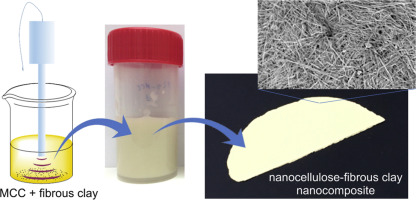当前位置:
X-MOL 学术
›
Appl. Clay. Sci.
›
论文详情
Our official English website, www.x-mol.net, welcomes your
feedback! (Note: you will need to create a separate account there.)
Ultrasound-assisted preparation of nanocomposites based on fibrous clay minerals and nanocellulose from microcrystalline cellulose
Applied Clay Science ( IF 5.3 ) Pub Date : 2020-05-01 , DOI: 10.1016/j.clay.2020.105538 M. Mar González del Campo , Borja Caja-Munoz , Margarita Darder , Pilar Aranda , Luis Vázquez , Eduardo Ruiz-Hitzky
Applied Clay Science ( IF 5.3 ) Pub Date : 2020-05-01 , DOI: 10.1016/j.clay.2020.105538 M. Mar González del Campo , Borja Caja-Munoz , Margarita Darder , Pilar Aranda , Luis Vázquez , Eduardo Ruiz-Hitzky

|
Abstract In the current work, ultrasound irradiation is used to obtain nanocomposite materials by assembling fibrous clay minerals (sepiolite or palygorskite) and nanocellulose (cellulose nanofibers, CNF), which can be directly produced from microcrystalline cellulose (MCC) through high-shear mechanical and sonomechanical treatments in the presence of the silicate. In this process, the ultrasound energy, evaluated from 1 to 50 kJ, produces the fibrillation from the outer layers of MCC together with partial disintegration of the amorphous regions, leading to high aspect ratio cellulose nanofibers with diameter below 100 nm and variable length around 1 μm. In the presence of sepiolite, a stable gel is formed due to the homogeneous dispersion of both organic and inorganic components, even at very low applied energies like 1 kJ. The generated biohybrid gels can be processed by solvent casting as self-standing films, which show an increase in the Young's modulus with respect to films of sonicated MCC alone, with the best results of 3.0 GPa for sepiolite loadings around 20–35% w/w. The ultrasound treatment produced also a strong decrease in the hydrophilicity of MCC when the applied energy was higher than 20 kJ, as determined from the corresponding water sorption isotherms. However, the applied energy does not affect the water sorption capacity of the nanocomposites containing sepiolite, showing similar isotherms for a given composition independently of the applied energy. The main difference among those nanocomposites is due to the sepiolite content, and thus, the isotherms corresponding to compositions with 20% w/w of sepiolite are closer to that of MCC alone. Those samples with low sepiolite loadings and prepared at applied energies of 20 kJ or higher also showed better water vapor transmission rates (WVTR). These results confirm that an optimal loading of 20% w/w sepiolite provided the lowest value of WVTR (286 g/m2 day) in comparison to nanocomposites with higher sepiolite content, while keeping good mechanical properties (Young's modulus of 2.8 GPa). This is an easy methodology for preparation of nanocellulose/fibrous clay minerals composite materials that allows the further incorporation of other functional nanoparticles such as carbon nanotubes, to obtain in this case biohybrid materials provided with electrical conductivity.
中文翻译:

超声辅助制备基于纤维粘土矿物和微晶纤维素纳米纤维素的纳米复合材料
摘要 在目前的工作中,超声辐照是通过组装纤维状粘土矿物(海泡石或坡缕石)和纳米纤维素(纤维素纳米纤维,CNF)来获得纳米复合材料,纳米纤维素可以通过高剪切机械和高剪切力直接由微晶纤维素(MCC)生产。在硅酸盐存在下进行声力学处理。在此过程中,评估为 1 至 50 kJ 的超声能量从 MCC 的外层产生原纤维化以及无定形区域的部分分解,导致直径低于 100 nm 且长度可变的高纵横比纤维素纳米纤维约为 1微米。在海泡石的存在下,即使在非常低的外加能量(如 1 kJ)下,由于有机和无机组分的均匀分散,也会形成稳定的凝胶。生成的生物混合凝胶可以通过溶剂浇铸作为自支撑膜进行加工,其显示出相对于单独超声处理的 MCC 膜的杨氏模量增加,对于海泡石负载量约为 20-35% w/的最佳结果为 3.0 GPa w. 根据相应的吸水等温线确定,当施加的能量高于 20 kJ 时,超声处理也使 MCC 的亲水性显着降低。然而,施加的能量不会影响含有海泡石的纳米复合材料的吸水能力,对于给定的组合物显示出相似的等温线,而与施加的能量无关。这些纳米复合材料之间的主要区别在于海泡石含量,因此,对应于含有 20% w/w 海泡石的组合物的等温线更接近于单独的 MCC。那些具有低海泡石负载量并在 20 kJ 或更高的应用能量下制备的样品也显示出更好的水蒸气透过率 (WVTR)。这些结果证实,与海泡石含量较高的纳米复合材料相比,20% w/w 海泡石的最佳负载提供最低的 WVTR 值(286 g/m2 天),同时保持良好的机械性能(杨氏模量为 2.8 GPa)。这是一种制备纳米纤维素/纤维状粘土矿物复合材料的简单方法,允许进一步掺入其他功能性纳米粒子,如碳纳米管,在这种情况下获得具有导电性的生物混合材料。这些结果证实,与海泡石含量较高的纳米复合材料相比,20% w/w 海泡石的最佳负载提供最低的 WVTR 值(286 g/m2 天),同时保持良好的机械性能(杨氏模量为 2.8 GPa)。这是一种制备纳米纤维素/纤维状粘土矿物复合材料的简单方法,允许进一步掺入其他功能性纳米粒子,如碳纳米管,在这种情况下获得具有导电性的生物混合材料。这些结果证实,与海泡石含量较高的纳米复合材料相比,20% w/w 海泡石的最佳负载提供最低的 WVTR 值(286 g/m2 天),同时保持良好的机械性能(杨氏模量为 2.8 GPa)。这是一种制备纳米纤维素/纤维状粘土矿物复合材料的简单方法,允许进一步掺入其他功能性纳米粒子,如碳纳米管,在这种情况下获得具有导电性的生物混合材料。
更新日期:2020-05-01
中文翻译:

超声辅助制备基于纤维粘土矿物和微晶纤维素纳米纤维素的纳米复合材料
摘要 在目前的工作中,超声辐照是通过组装纤维状粘土矿物(海泡石或坡缕石)和纳米纤维素(纤维素纳米纤维,CNF)来获得纳米复合材料,纳米纤维素可以通过高剪切机械和高剪切力直接由微晶纤维素(MCC)生产。在硅酸盐存在下进行声力学处理。在此过程中,评估为 1 至 50 kJ 的超声能量从 MCC 的外层产生原纤维化以及无定形区域的部分分解,导致直径低于 100 nm 且长度可变的高纵横比纤维素纳米纤维约为 1微米。在海泡石的存在下,即使在非常低的外加能量(如 1 kJ)下,由于有机和无机组分的均匀分散,也会形成稳定的凝胶。生成的生物混合凝胶可以通过溶剂浇铸作为自支撑膜进行加工,其显示出相对于单独超声处理的 MCC 膜的杨氏模量增加,对于海泡石负载量约为 20-35% w/的最佳结果为 3.0 GPa w. 根据相应的吸水等温线确定,当施加的能量高于 20 kJ 时,超声处理也使 MCC 的亲水性显着降低。然而,施加的能量不会影响含有海泡石的纳米复合材料的吸水能力,对于给定的组合物显示出相似的等温线,而与施加的能量无关。这些纳米复合材料之间的主要区别在于海泡石含量,因此,对应于含有 20% w/w 海泡石的组合物的等温线更接近于单独的 MCC。那些具有低海泡石负载量并在 20 kJ 或更高的应用能量下制备的样品也显示出更好的水蒸气透过率 (WVTR)。这些结果证实,与海泡石含量较高的纳米复合材料相比,20% w/w 海泡石的最佳负载提供最低的 WVTR 值(286 g/m2 天),同时保持良好的机械性能(杨氏模量为 2.8 GPa)。这是一种制备纳米纤维素/纤维状粘土矿物复合材料的简单方法,允许进一步掺入其他功能性纳米粒子,如碳纳米管,在这种情况下获得具有导电性的生物混合材料。这些结果证实,与海泡石含量较高的纳米复合材料相比,20% w/w 海泡石的最佳负载提供最低的 WVTR 值(286 g/m2 天),同时保持良好的机械性能(杨氏模量为 2.8 GPa)。这是一种制备纳米纤维素/纤维状粘土矿物复合材料的简单方法,允许进一步掺入其他功能性纳米粒子,如碳纳米管,在这种情况下获得具有导电性的生物混合材料。这些结果证实,与海泡石含量较高的纳米复合材料相比,20% w/w 海泡石的最佳负载提供最低的 WVTR 值(286 g/m2 天),同时保持良好的机械性能(杨氏模量为 2.8 GPa)。这是一种制备纳米纤维素/纤维状粘土矿物复合材料的简单方法,允许进一步掺入其他功能性纳米粒子,如碳纳米管,在这种情况下获得具有导电性的生物混合材料。











































 京公网安备 11010802027423号
京公网安备 11010802027423号